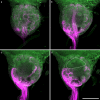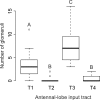Olfactory subsystems in the honeybee: sensory supply and sex specificity
- PMID: 24817103
- PMCID: PMC4148592
- DOI: 10.1007/s00441-014-1892-y
Olfactory subsystems in the honeybee: sensory supply and sex specificity
Abstract
The antennae of honeybee (Apis mellifera) workers and drones differ in various aspects. One striking difference is the presence of Sensilla basiconica in (female) workers and their absence in (male) drones. We investigate the axonal projection patterns of olfactory receptor neurons (ORNs) housed in S. basiconica in honeybee workers by using selective anterograde labeling with fluorescent tracers and confocal-microscopy analysis of axonal projections in antennal lobe glomeruli. Axons of S. basiconica-associated ORNs preferentially projected into a specific glomerular cluster in the antennal lobe, namely the sensory input-tract three (T3) cluster. T3-associated glomeruli had previously been shown to be innervated by uniglomerular projection (output) neurons of the medial antennal lobe tract (mALT). As the number of T3 glomeruli is reduced in drones, we wished to determine whether this was associated with the reduction of glomeruli innervated by medial-tract projection neurons. We retrogradely traced mALT projection neurons in drones and counted the innervated glomeruli. The number of mALT-associated glomeruli was strongly reduced in drones compared with workers. The preferential projections of S. basiconica-associated ORNs in T3 glomeruli together with the reduction of mALT-associated glomeruli support the presence of a female (worker)-specific olfactory subsystem that is partly innervated by ORNs from S. basiconica and is associated with the T3 cluster of glomeruli and mALT projection neurons. We propose that this olfactory subsystem supports parallel olfactory processing related to worker-specific olfactory tasks such as the coding of colony odors, colony pheromones and/or odorants associated with foraging on floral resources.
Figures







Similar articles
-
Sensillum-specific, topographic projection patterns of olfactory receptor neurons in the antennal lobe of the cockroach Periplaneta americana.J Comp Neurol. 2012 Jun 1;520(8):1687-701. doi: 10.1002/cne.23007. J Comp Neurol. 2012. PMID: 22121009
-
Multiple olfactory receptor neurons and their axonal projections in the antennal lobe of the honeybee Apis mellifera.J Comp Neurol. 2006 May 20;496(3):395-405. doi: 10.1002/cne.20930. J Comp Neurol. 2006. PMID: 16566001
-
Physiology and antennal lobe projections of olfactory receptor neurons from sexually isomorphic sensilla on male Heliothis virescens.J Comp Physiol A Neuroethol Sens Neural Behav Physiol. 2007 Jun;193(6):649-63. doi: 10.1007/s00359-007-0220-3. Epub 2007 Apr 13. J Comp Physiol A Neuroethol Sens Neural Behav Physiol. 2007. PMID: 17431638
-
Glomerular interactions in olfactory processing channels of the antennal lobes.J Comp Physiol A Neuroethol Sens Neural Behav Physiol. 2013 Nov;199(11):929-46. doi: 10.1007/s00359-013-0842-6. Epub 2013 Jul 28. J Comp Physiol A Neuroethol Sens Neural Behav Physiol. 2013. PMID: 23893248 Free PMC article. Review.
-
Parallel processing in the honeybee olfactory pathway: structure, function, and evolution.J Comp Physiol A Neuroethol Sens Neural Behav Physiol. 2013 Nov;199(11):981-96. doi: 10.1007/s00359-013-0821-y. Epub 2013 Apr 23. J Comp Physiol A Neuroethol Sens Neural Behav Physiol. 2013. PMID: 23609840 Free PMC article. Review.
Cited by
-
The Pheromone Landscape of Apis mellifera: Caste-Determined Chemical Signals and Their Influence on Social Dynamics.Molecules. 2025 May 29;30(11):2369. doi: 10.3390/molecules30112369. Molecules. 2025. PMID: 40509256 Free PMC article. Review.
-
The neuroethology of olfactory sex communication in the honeybee Apis mellifera L.Cell Tissue Res. 2021 Jan;383(1):177-194. doi: 10.1007/s00441-020-03401-8. Epub 2021 Jan 15. Cell Tissue Res. 2021. PMID: 33447877 Review.
-
Two Parallel Olfactory Pathways for Processing General Odors in a Cockroach.Front Neural Circuits. 2017 May 5;11:32. doi: 10.3389/fncir.2017.00032. eCollection 2017. Front Neural Circuits. 2017. PMID: 28529476 Free PMC article.
-
Comparative study of chemical neuroanatomy of the olfactory neuropil in mouse, honey bee, and human.Biol Cybern. 2018 Apr;112(1-2):127-140. doi: 10.1007/s00422-017-0728-8. Epub 2017 Aug 29. Biol Cybern. 2018. PMID: 28852854 Free PMC article.
-
Hornets Have It: A Conserved Olfactory Subsystem for Social Recognition in Hymenoptera?Front Neuroanat. 2017 Jun 14;11:48. doi: 10.3389/fnana.2017.00048. eCollection 2017. Front Neuroanat. 2017. PMID: 28659767 Free PMC article.
References
-
- Ågren L. Flagellar sensilla of some colletidae (Hymenoptera: Apoidea) Int J Insect Morphol Embryol. 1977;6:137–146. doi: 10.1016/0020-7322(77)90002-2. - DOI
-
- Ågren L. Flagellar sensilla of two species of Andrena (Hymenoptera: Andrenidae) Int J Insect Morphol Embryol. 1978;7:73–79. doi: 10.1016/S0020-7322(78)80016-6. - DOI
-
- Ågren L, Hallberg E. Flagellar sensilla of bumble bee males (Hymenopera, Apidae, Bombus) Apidologie. 1996;27:433–444. doi: 10.1051/apido:19960601. - DOI
MeSH terms
LinkOut - more resources
Full Text Sources
Other Literature Sources
Research Materials

